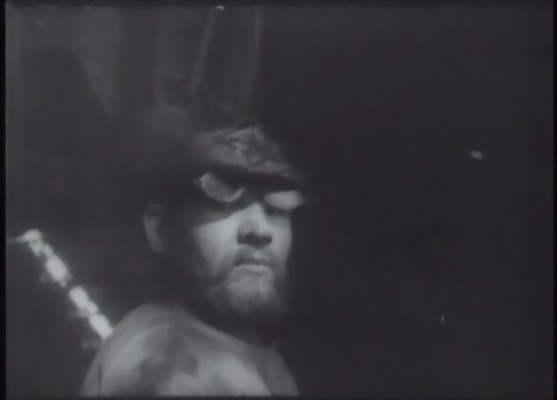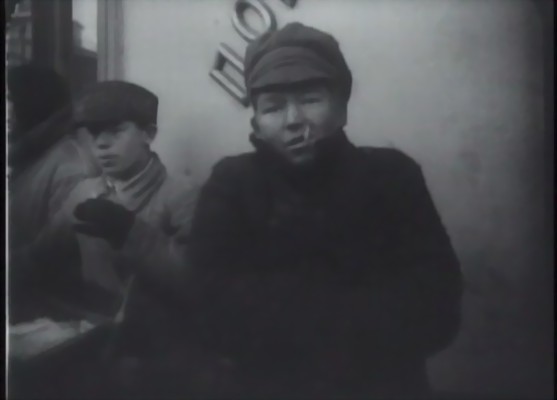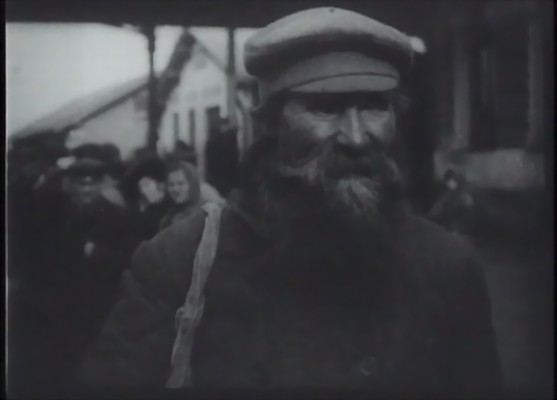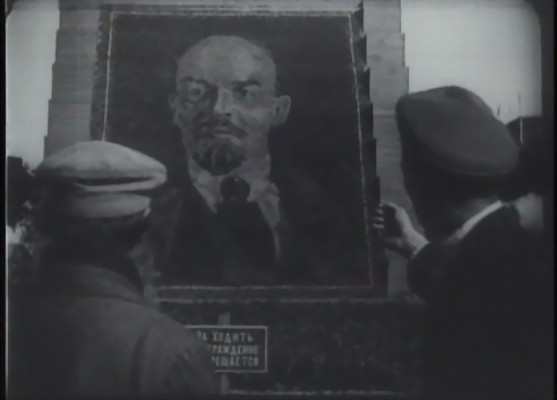This disc brings together a collection of newsreels, which were shown in the early days of the USSR under the title "Kino Pravda" (as well as "Kino Nedelya" and "Kino Glaz"). Kino-Pravda ("Film Truth") was a newsreel series by Dziga Vertov, Elizaveta Svilova, and Mikhail Kaufman.
Working mainly during the 1920s, Vertov promoted the concept of kino-pravda, or film-truth, through his newsreel series. His driving vision was to capture fragments of actuality which, when organized together, showed a deeper truth which could not be seen with the naked eye. In the "Kino-Pravda" series, Vertov focused on everyday experiences, eschewing bourgeois concerns and filming marketplaces, bars, and schools instead, sometimes with a hidden camera, without asking permission first. Episodes of "Kino-Pravda" usually did not include reenactments or stagings (one exception is the segment about the trial of the Social Revolutionaries: the scenes of the selling of the newspapers on the streets and the people reading the papers in the trolley were both staged for the camera). The cinematography is simple, functional, unelaborate — perhaps a result of Vertov's lack of interest in either "beauty" or "art". Twenty-three issues of the series were produced over a period of three years; each issue lasted about twenty minutes and usually covered three topics. The stories were typically descriptive, not narrative, and included vignettes and exposés, showing for instance the renovation of a trolley system, the organization of farmers into communes, and the trial of Social Revolutionaries; one story shows starvation in the nascent Marxist state. Propagandistic tendencies are also present, but with more subtlety, in the episode featuring the construction of an airport: one shot shows the former Czar's tanks helping prepare a foundation, with an intertitle reading "Tanks on the labor front".
Vertov clearly intended an active relationship with his audience in the series — in the final segment he includes contact information — but by the fourteenth episode the series had become so experimental that some critics dismissed Vertov's efforts as "insane".
KINO PRAVDA 15 (1923):
conference on disarmament, atheistic propaganda, Timiryazev monument opening, promotion of sport
SILENT FILM WITH RUSSIAN INTERTITLES AND SWITCHABLE ENGLISH SUBTITLES. APPROXIMATELY 16 MINUTES
KINO PRAVDA 17 (1923):
The First All-Russian Agricultural Exhibition
SILENT FILM WITH RUSSIAN INTERTITLES AND SWITCHABLE ENGLISH SUBTITLES. APPROXIMATELY 15 MINUTES
KINO PRAVDA 18 (1924):
Kino-Pravda No. 18 takes the viewer from West to East; Kino-Pravda 19, from North to South. Kino-Pravda No. 18 ("A race in the direction of Soviet reality"), was conceived as a journey on more than one level. It looks like a journey because Vertov starts with found footage filmed in Paris, and moves on to the footage shot in Russia, and it certainly feels like one — for the sequence that links Paris and Moscow has been assembled from travelling shots. It is not just a camera race, it is a relay race: Vertov edits together various kinds of camera movement, reflecting the camera’s mode of transport. We are first taken up the Eiffel Tower, its magnificent girders slowly gliding by (this movie-camera ascent, the title tells us, is dedicated to the memory of the tower’s builder — Gustave Eiffel died in 1923). From there, a plane takes over. A title, "The movie camera lands in the territory of the USSR," is followed by a shot taken from the undercarriage of a descending airplane, as fields and meadows loom up rapidly below us. As the movie camera lands, it is taken over by a racing car ("Auto race Petrograd-Moscow," the title reads). This is perhaps the closest Vertov’s film practice ever came to his somewhat elusive theoretical concept of "intervals", formulated in his manifesto "We" in 1922: "Kinoculism is the art of organizing the necessary movements of objects in space as a rhythmical artistic whole, in harmony with the properties of the material and the internal rhythm of each object. Intervals (the transition from one movement to another) are the material, the element of the art of movement, and by no means the movements themselves. It is they (the intervals) which draw the movement to a kinetic resolution."
As usual, smychka (announced by its signature emblem, the handshake) is one of the dominant themes in Kino-Pravda No. 18, but here Vertov decides to illustrate it in an off-beat way. The movie camera picks out a bearded man in the crowd, who turns out to be a peasant, Vasilii Siriakov, who has come all the way from Yaroslav Province to see Moscow, and the camera shows us Moscow through the peasant’s eye. "The movie camera pursues him," a title announces, whereupon a shadow of a man cranking a movie camera is shown. "The same peasant on his way to the Agricultural Exhibition" — and Siriakov is shown riding on a tram, all the while observing the tram conductor and the driver at work. The camera shadows our peasant everywhere. At one point he winds up in a Goskino workshop — at the moment when a baby is being Octobrized. What does this mean, "Octobrized"? The same as baptized — but in a workers’ collective instead of a church, and into Communism rather than a religion. (Invented with an eye to replacing church christening, this stopgap ritual never took root.) What is the best name for a newborn boy? You guessed it — and in an extreme close-up, we see the name "Vladimir" emerging from a worker’s mouth. All present are singing (guess which song?) as the boy is passed around — from a Communist worker to a Komsomol youngster and to a Young Pioneer. "To the Red Citizen Vladimir" (more singing faces) "grow healthy, Comrade" (close-up of hands holding the baby in the air). Workers at work. "Vladimir." Machine-tools at work. "Vladimir." The editing accelerates. "Vladimir." And intercut with all this, the recurrent shadow of the man with the camera, at work.




SILENT FILM WITH RUSSIAN INTERTITLES AND SWITCHABLE ENGLISH SUBTITLES. APPROXIMATELY 13 MINUTES
KINO PRAVDA 19 (1924):
Issue 19 tries to do many things at once — maybe a little too many for one reel. First, it contrasts cold and hot, winter and summer, Russia’s arctic regions and Russia’s Southern sea (named Black). Perhaps Eisenstein had a point when he said, with his usual deadly wit, that Vertov’s dream was to lick Nanook and Moana in one fell swoop (see the chapter "Vertov versus Eisenstein" in Lines of Resistance). Secondly, Vertov dedicates this issue of Kino-Pravda to "Woman, peasant woman, worker woman", a theme which defines the dominant gender of this film, particularly towards the end. A young woman types; another woman milks a cow; another works a field, etc. Women in politics: a State woman speaks; Lenin’s wife and sister — shown at Lenin’s funeral, and by his side when he was still alive. And at the very end, pro domo sua: "The editing of the negative for Kino-Pravda No. 19," says the title, and Vertov’s wife, the kinoc editor Elizaveta Svilova, is shown editing the very film we are watching. Déjà vu? If so, then in reverse: there is a similar sequence in Man with a Movie Camera, a film yet to be made.
There is also another sequence in Kino-Pravda No. 19 which anticipates a similar trick from Man with a Movie Camera (and, in a strange way, brings to mind that early British film, How It Feels to Be Run Over). This issue, as the one released before it, is a camera race, so images of women doing different jobs are connected by a recurrent subject: a train in movement, often with the movie camera mounted on the car roof. At one point a curious intertitle informs us: "4 metres of movie-camera memory, as it falls under the wheels of the freight train." The huge wheels flash by; a view from under the train. That’s it. The last 4 metres of what the movie camera remembers. Evidently, in the eyes of the kinocs their kino-eye was a living being
SILENT FILM WITH RUSSIAN INTERTITLES AND SWITCHABLE ENGLISH SUBTITLES. THIS FILM HAS NO SOUND AT ALL. APPROXIMATELY 16 MINUTES.
KINO PRAVDA 20 (1924):
Tour the pioneers (members of ?hild communist organization) in the village and zoological garden
SILENT FILM WITH RUSSIAN INTERTITLES AND SWITCHABLE ENGLISH SUBTITLES. APPROXIMATELY 12 MINUTES.
ALL FILMS HAVE HAD MUSIC ADDED TO THEM WITH THE EXCEPTION OF KINO-PRAVDA 19.
TOTAL RUNNING TIME: 72 MINUTES.




